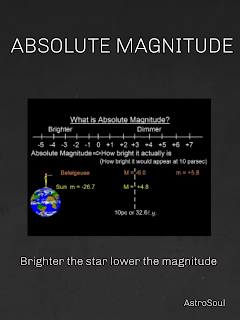"...Looking at the stars always makes me dream , as simply as i dream over the black dots representing towns and villages on map. Why, i asked myself shouldn't the shiny dots of sky be as accessible as black dots on the map of France"
-Vincent Van Gogh
Study of heavens is older than study of navigation, agriculture and even language itself. It is one of the oldest sciences ever studied . From the dawn of civilisation , humans have wondered about twinkling dots above their heads , far far away from the reach. Study of these twinkling dots has laid down the most important building blocks in arousing the curiosity of mankind into knowing - who we are ?
Stars are all born in nebuli , the cloud of dust. With the gravity working is magic , dust and gas start to collapse. As the temperature rises further stellar evolution continues ; thermonuclear fusion begins, forming helium and we get heat and light .
How far away are stars?
It seems impossible to understand stars, unless one has an understanding of tackling distances between them. Taking the understandings of Greeks in measuring the distance of moon forward , we reached the stars .
Let's first understand the term parallax - Its the apparent shift in position of an object when it is viewed along different positions. Eg. hold a pencil in your hand and extend your arm. Notice the shift in position of pencil as you view it through your one eye keeping the other closed at a time. Your eyes have a certain distance between them that causes this parallax . Similar shift in the position of star occurs when it is viewed from different locations of earth and the astronomers didn't spare this and made it one of the most powerful tools of astronomy !
Let me show you how -
As seasons change, the location of stars in the sky changes - this apparent change in the position of the star when viewed from different points on earth is called - Parallax.
We take the benefit of this observation and by measuring the position of the star in the sky 6 months apart , by simple mathematics , we get the distance to stars .
we already knew the distance from sun to earth( 1 AU )
we measured the angle' alpha 'from earth and putting all in formula -
alpha= (1 AU)/d , we get the distance to the star.
But the process is not as straight forward as it looks , twinkling of stars - though soothing to eyes are a major trouble for astronomers because it limits the accuracy to which the position of star is known .
One way to solve this problem is to have thousand of observations to get the accurate position of star and the other is to position our telescopes outside the atmosphere of earth to avoid turbulence due to atmosphere and get the measurement of accurate position. That's why we have most of the telescopes placed higher up in atmosphere.
Everytime we need to measure the position of a star , it's tedious to take thousands of observations . This parallax method surely has limitations . Is there a better way?( yes obviously , else why would i be having this question here ) . It lies in measuring the brightness of star.
How bright are stars and how to measure the brightness?
Let's first talk about brightness in daily life. You go to market and purchase 1000 W bulb. This bulb gives off 1000 Joules of energy in one second. Physicists call this term luminosity.
The other term is apparent brightness. It describes how a star gets dimmer and dimmer as it gets far away. We use this relationship between distance and brightness to a great extent in astronomy.
How Astronomers measure the brightness?
Stars radiate enormous amount of energy so thy don't use units like Watts cuz that will be very inconvenient.
The apparent luminosity of of a star is descirbed as
apparent magnitude (m) and
total luminosity is described as absolute magnitude (M)-magnitude of an object placed 10 pc away.

Where parsec(pc) is the distance which a star has to travel for it's parallax to be 3.26 light year(light year is equal to the distance light travels in one year = speed of light(m/s) * no. of seconds in an year)
The construction of magnitude scales was done on the basis of the most fundamental logic-
Our eyes are more sensitive to geometric than arithmetic progression.
This fact can be understood very easily as you will be able to distinguish more clearly in between two bulbs if brightness of one bulb is greater than that of other by a factor 5 i.e b1=5*b2
than if the brightness of one bulb is 5 + greater than the other , i.e b1=b2+5.
There are two things which we need to note about these magnitudes here -
The scale runs on logarithmic scale ( magnitude of one star is dimmer than other by same factor)and backwards( higher the magnitude , dimmer the star )
Here is the mathematical expression for apparent magnitude-
m1 - m2 = -2.5 * log( B1/B2) where m1 , m2 and B1 , B2 are magnitudes and brightness of objects respectively.
and here is mathematical expression for absolute magnitude- m-M = 2.5 log (d/10)^2
If the object is at a distance d pc, then (10/d)^2 is the ratio of its apparent brightness and the brightness it would have if it were at a distance of 10pc.
Starlight deciphering the mysteries of cosmos
Stars send us message encoded in the starlight. We decode this message by studying the spectrum of stars, we can encode many things, like what is the star made up of , the age of star .
Suppose two stars have same spectrum, one is near and one is very far away . If spectra of two stars is identical then experience has shown astronomers that the two stars will also be very similar in their other properties, such as their mass, radius, and total luminosity. If it turns out that the second star has apparent luminosity that is only one ninth that of 1st one , then it is likely that this is because the star is thrice as far away, so that its light is spread over a sphere whose area is nine times as large as that of the first one. Noticed how cleverly we figured out distance here ? This is what astronomers use to take account of very large distances.
well..this is not the end to the story still , we got a lot of information from a single twinkling speck on the sky , that realisation is awesome in itself. I wonder , what it would be like decoding every single bit of information that is given to us ! Our ancestors were definitely excellent at it ; we owe our understanding to all those curious , passionate and brave minds who decoded the biggest mysteries without any basic tools. There is still a long long way to go .. Every piece of the sky tells a story , just be curious enough to decipher one.

























